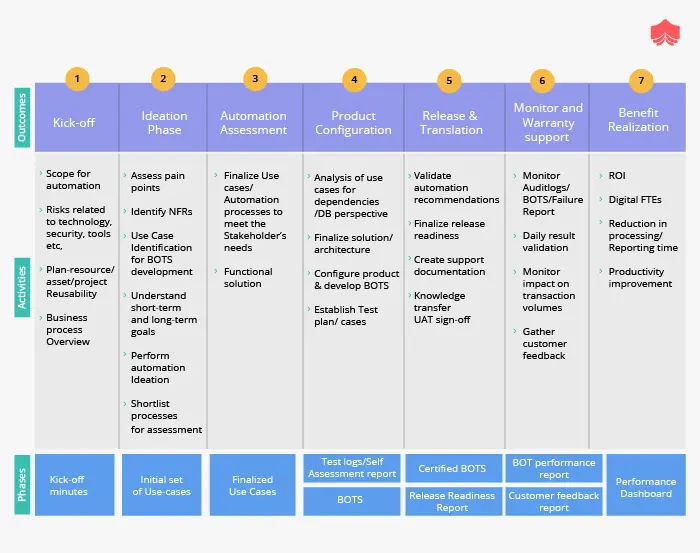- Blog Categories
- Project Management
- Agile Management
- IT Service Management
- Cloud Computing
- Business Management
- Business Intelligence
- Quality Engineer
- Cyber Security
- Career
- Big Data
- Programming
- Most Popular Blogs
- PMP Exam Schedule for 2024: Check PMP Exam Date
- Top 60+ PMP Exam Questions and Answers for 2024
- PMP Cheat Sheet and PMP Formulas To Use in 2024
- What is PMP Process? A Complete List of 49 Processes of PMP
- Top 15+ Project Management Case Studies with Examples 2024
- Top Picks by Authors
- Top 170 Project Management Research Topics
- What is Effective Communication: Definition
- How to Create a Project Plan in Excel in 2024?
- PMP Certification Exam Eligibility in 2024 [A Complete Checklist]
- PMP Certification Fees - All Aspects of PMP Certification Fee
- Most Popular Blogs
- CSM vs PSM: Which Certification to Choose in 2024?
- How Much Does Scrum Master Certification Cost in 2024?
- CSPO vs PSPO Certification: What to Choose in 2024?
- 8 Best Scrum Master Certifications to Pursue in 2024
- Safe Agilist Exam: A Complete Study Guide 2024
- Top Picks by Authors
- SAFe vs Agile: Difference Between Scaled Agile and Agile
- Top 21 Scrum Best Practices for Efficient Agile Workflow
- 30 User Story Examples and Templates to Use in 2024
- State of Agile: Things You Need to Know
- Top 24 Career Benefits of a Certifed Scrum Master
- Most Popular Blogs
- ITIL Certification Cost in 2024 [Exam Fee & Other Expenses]
- Top 17 Required Skills for System Administrator in 2024
- How Effective Is Itil Certification for a Job Switch?
- IT Service Management (ITSM) Role and Responsibilities
- Top 25 Service Based Companies in India in 2024
- Top Picks by Authors
- What is Escalation Matrix & How Does It Work? [Types, Process]
- ITIL Service Operation: Phases, Functions, Best Practices
- 10 Best Facility Management Software in 2024
- What is Service Request Management in ITIL? Example, Steps, Tips
- An Introduction To ITIL® Exam
- Most Popular Blogs
- A Complete AWS Cheat Sheet: Important Topics Covered
- Top AWS Solution Architect Projects in 2024
- 15 Best Azure Certifications 2024: Which one to Choose?
- Top 22 Cloud Computing Project Ideas in 2024 [Source Code]
- How to Become an Azure Data Engineer? 2024 Roadmap
- Top Picks by Authors
- Top 40 IoT Project Ideas and Topics in 2024 [Source Code]
- The Future of AWS: Top Trends & Predictions in 2024
- AWS Solutions Architect vs AWS Developer [Key Differences]
- Top 20 Azure Data Engineering Projects in 2024 [Source Code]
- 25 Best Cloud Computing Tools in 2024
- Most Popular Blogs
- Company Analysis Report: Examples, Templates, Components
- 400 Trending Business Management Research Topics
- Business Analysis Body of Knowledge (BABOK): Guide
- ECBA Certification: Is it Worth it?
- How to Become Business Analyst in 2024? Step-by-Step
- Top Picks by Authors
- Top 20 Business Analytics Project in 2024 [With Source Code]
- ECBA Certification Cost Across Countries
- Top 9 Free Business Requirements Document (BRD) Templates
- Business Analyst Job Description in 2024 [Key Responsibility]
- Business Analysis Framework: Elements, Process, Techniques
- Most Popular Blogs
- Best Career options after BA [2024]
- Top Career Options after BCom to Know in 2024
- Top 10 Power Bi Books of 2024 [Beginners to Experienced]
- Power BI Skills in Demand: How to Stand Out in the Job Market
- Top 15 Power BI Project Ideas
- Top Picks by Authors
- 10 Limitations of Power BI: You Must Know in 2024
- Top 45 Career Options After BBA in 2024 [With Salary]
- Top Power BI Dashboard Templates of 2024
- What is Power BI Used For - Practical Applications Of Power BI
- SSRS Vs Power BI - What are the Key Differences?
- Most Popular Blogs
- Data Collection Plan For Six Sigma: How to Create One?
- Quality Engineer Resume for 2024 [Examples + Tips]
- 20 Best Quality Management Certifications That Pay Well in 2024
- Six Sigma in Operations Management [A Brief Introduction]
- Top Picks by Authors
- Six Sigma Green Belt vs PMP: What's the Difference
- Quality Management: Definition, Importance, Components
- Adding Green Belt Certifications to Your Resume
- Six Sigma Green Belt in Healthcare: Concepts, Benefits and Examples
- Most Popular Blogs
- Latest CISSP Exam Dumps of 2024 [Free CISSP Dumps]
- CISSP vs Security+ Certifications: Which is Best in 2024?
- Best CISSP Study Guides for 2024 + CISSP Study Plan
- How to Become an Ethical Hacker in 2024?
- Top Picks by Authors
- CISSP vs Master's Degree: Which One to Choose in 2024?
- CISSP Endorsement Process: Requirements & Example
- OSCP vs CISSP | Top Cybersecurity Certifications
- How to Pass the CISSP Exam on Your 1st Attempt in 2024?
- Most Popular Blogs
- Best Career options after BA [2024]
- Top Picks by Authors
- Top Career Options & Courses After 12th Commerce in 2024
- Recommended Blogs
- 30 Best Answers for Your 'Reason for Job Change' in 2024
- Recommended Blogs
- Time Management Skills: How it Affects your Career
- Most Popular Blogs
- Top 28 Big Data Companies to Know in 2024
- Top Picks by Authors
- Top Big Data Tools You Need to Know in 2024
- Most Popular Blogs
- Web Development Using PHP And MySQL
- Top Picks by Authors
- Top 30 Software Engineering Projects in 2024 [Source Code]
- More
- Tutorials
- Practise Tests
- Interview Questions
- Free Courses
- Agile & PMP Practice Tests
- Agile Testing
- Agile Scrum Practice Exam
- CAPM Practice Test
- PRINCE2 Foundation Exam
- PMP Practice Exam
- Cloud Related Practice Test
- Azure Infrastructure Solutions
- AWS Solutions Architect
- AWS Developer Associate
- IT Related Pratice Test
- ITIL Practice Test
- Devops Practice Test
- TOGAF® Practice Test
- Other Practice Test
- Oracle Primavera P6 V8
- MS Project Practice Test
- Project Management & Agile
- Project Management Interview Questions
- Release Train Engineer Interview Questions
- Agile Coach Interview Questions
- Scrum Interview Questions
- IT Project Manager Interview Questions
- Cloud & Data
- Azure Databricks Interview Questions
- AWS architect Interview Questions
- Cloud Computing Interview Questions
- AWS Interview Questions
- Kubernetes Interview Questions
- Web Development
- CSS3 Free Course with Certificates
- Basics of Spring Core and MVC
- Javascript Free Course with Certificate
- React Free Course with Certificate
- Node JS Free Certification Course
- Data Science
- Python Machine Learning Course
- Python for Data Science Free Course
- NLP Free Course with Certificate
- Data Analysis Using SQL
Metrics Management In Automation Projects-Deliver Value Endlessly In Your Agile Projects
By Lindy Quick
Updated on Oct 26, 2018 | 3 min read | 8.4k views
Share:
Introduction
Projects have been executed for decades for many reasons including customer requirements, technological advancements, and compliance requirements etc. The success of the projects has been driven mostly by conformance to plan for plan-driven projects and the value of delivery for the Agile projects.
There are many factors that attribute to the success of the projects and had helped project managers steer projects in the right directions, take corrective and preventive actions.
Metrics is one of the most important aspects of project management which can assess if your existing project or program is doing enough to justify your existence. A metric, by definition, is any type of measurement used to measure some quantifiable component of performance. A metric can be collected through observation, such as delay in days, or number of defects; or the metric can be derived from directly observable quantities, such as defects per “x” lines of code, a cost performance index (CPI), or a schedule performance index (SPI) Metric is also called as an indicator, or a key performance indicator (KPI). We will see how metrics can manage automation projects effectively to realize its goals and objectives.
Why Automation?

Insider Tips to Land Your Dream Scrum Master Job
Includes Scrum Resume Sample

We’ve witnessed so far application or product being built to solve a customers’ problem. Most of the applications including e-commerce are now being based on human-centered design or user-centric. These processes were in place and able to sustain when business productivity
trumped technology productivity.
Technology took mainstream lately and enterprises started identifying opportunities for automation to cut costs and invest more in the development of new business to grow their top line. RPA product companies took advantage of these opportunities and came up with new age automation suites to solve clients needs thereby saving millions of dollars in costs.
What to Automate?
Rule-based Automation

There are applications or systems that involved repetitive actions from users. For example. invoice processing, purchase order approvals, invoice reconciliation etc. These opportunities became the low hanging fruits for the enterprises to invest on. If you see really, these are rule-based systems that work based on if-else conditions.
The rule-based automation products came to limelight in recent years and demonstrated the possibility of automating these user interactions with the system and in fact reduced the error or exception rates drastically down.
Intelligent Process Automation

There are also applications that would require high-level behavior to do automation. For exp- to approve an invoice, the automation system should be able to read different formats of a document like pdf, doc, tiff, etc. It has to identify different fields in the invoice document like PO number, Vendor Name, Line item etc. But a lot of the times, these documents will not be structurally formatted and emphasizes the need for some kind of intelligence. This is where some NLP based systems can identify different structures, formats to effectively automate these systems.
Metrics for Improving the success of Automated Projects
Every organization has its own approach for managing automation projects and have come up with assessments and frameworks to deliver benefits to their clients on their automation journey. There are multiple phases associated with the assessment framework and the below framework can help any automation projects reach its goal and measure the maturity level.

The phases are,
- Kick-off
- This is where the what part of the automation use cases are defined. Risks are identified along with mitigation plans.
- Ideation
- The use cases for automation are brainstormed for BOTs development.
- Assessment
- Use cases are finalized based on different techniques.
- Configuration
- Architecture is finalized along with dependencies with related components.
- Release & Transition
- BOTs are certified, deployed and marked for the transition to the operations team.
- Monitor & Support
- Monitor logs, failures, exceptions and get customer feedback on implementation
- Benefits Realization
- ROI, Productivity improvement, FTE reductions details are gathered
Looking to advance your understanding of project management principles and propel your career to new heights? Our PRINCE2 Foundation certification course offers a comprehensive program that enables you to develop expertise in this field and become a certified PRINCE2 practitioner. Enroll now in our expert-led program to unlock your full potential!
How to measure Automation success in projects?
Metrics is one of the most important aspects of project management. Project managers use the metrics to track the project progress against the plan. It serves as a navigation system for them and can be used to drive towards the project goal.
The metrics can aid project managers to identify pitfalls and shortcomings ahead of time thereby providing enough time for the project managers to make proactive and corrective measures.
There are generally 6 factors that managers generally measure to create metrics that determine project success. Let’s see those metrics for implementing the Automated projects.

- Value delivered to the client.
- Time/Schedule to deliver project deliverables. (under / on / over)
- Cost to deliver project (under / on / over)
- Scope of work to be delivered. (addition / deletion)
- Quality of deliverables and of the process. (Benchmarks met if any)
- Risks to project success (Mitigation / Contingency plans)
Automation metrics are no different than traditional project metrics but have few variations on what metrics needs to be tracked to effectively manage the projects and deliver the desired outcomes.
| Metric | Operation Definition | Outcomes |
|---|---|---|
| Man to BOT Ratio | Number of Bots VS Number of FTE in the Team |
Time of Market,TCO |
| % of reusable components | (Number of components reused/Total number of components)*100 | Time of market |
| % reduction in FTE | (Number of FTE released due to BOTS/Number of FTEs before the BOTS release)*100 | Time of market |
| Thoughput | (Time is taken before automation-time taken after automation/time taken before automation)*100 | Time of market |
| ROI | Total cost saving/ overall cost of implementation | TCO |
| BOT resolution | Number of tickets resolved byBOTS/Overall number of tickets | Time of market |
| Cycle time | Average time to implement a bot(from requirement to production) | Time of market |
Automation metrics can be chosen based on the type of the projects being executed as listed above and are applicable to RPA/IPA projects as well. The major factors to be considered while executing the automation projects are,
- What problem is your BOT solving for the customer?
- Have you worked out the cost benefit for the BOT?
- What is the right RPA tool for your business need?
- Have you considered the scalability of BOTs, ease of implementation and robustness?
Conclusion
Automation is here to stay and will continue to evolve. McKinsey report says nearly half of the activities that people do can be automated theoretically using current technologies. As we progress to foreseeable future, more and more projects will embrace automation leaving humans to solve the most complex problems.
The metrics management approach and defined a set of metrics may be suitable for a particular automation team and not suitable for another team depending on the nature of the automation, but it has worked out pretty good for me so far.
Get Free Consultation
By submitting, I accept the T&C and
Privacy Policy
Ready to lead with Scrum expertise?


